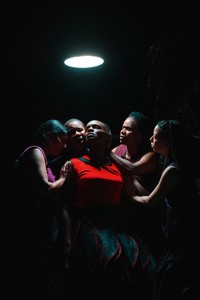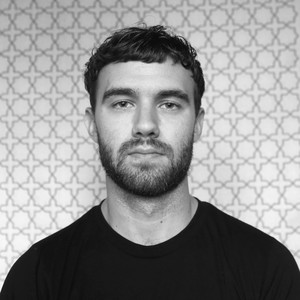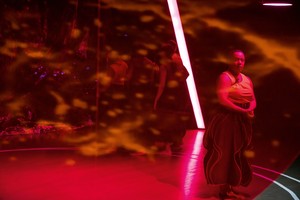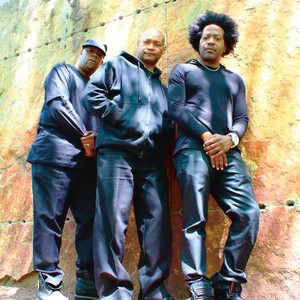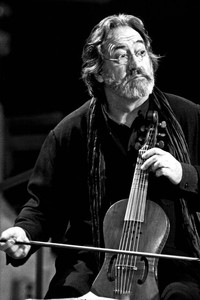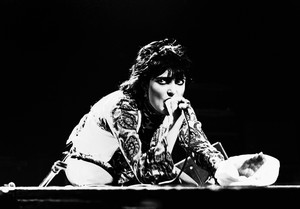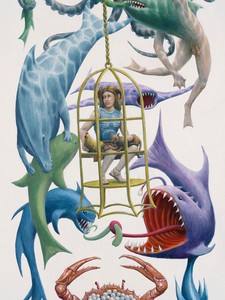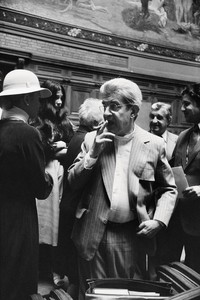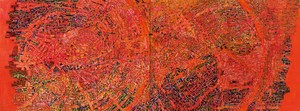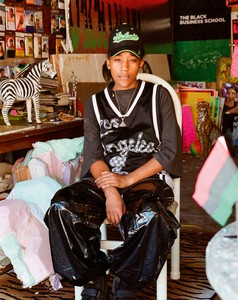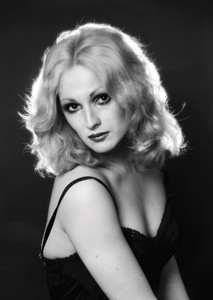When the audience entered LA’s redcat theater for the opening night of Okwui Okpokwasili’s adaku, part 1: the road opens, Okpokwasili and her collaborators were already at work. In close formation, the seven performers stomped to a consistent rhythm, treaded strongly in the earth, chanting together about ancestry, lineage, movement, and a gateway. The collective—a “coven of witches,” as Okpokwasili later described them—moved steadily along a circular path marked on the stage. They continued this marking of space for some time without relenting their rhythm, maintaining a pulse, driving the work forward. From this engine emerged three characters: a matriarch leader extolling the importance of family lineage and futurity; an artist whose enigmatic carvings revealed unwanted truths to the community; and the matriarch’s daughter, a protegée of the artist’s. The story that unfolded over the sixty-minute performance centered on the interpretation of the artist’s work and its implications for the culture, its revelations about history and trauma, whether people can bear to face those truths, and a final devastation inflicted on the community. But the engine was always driving onward, supporting the characters’ warring motivations. The circling chorus, responding to calls from the actors in unison, continued to carve out the circle, to “open the road.”
What is this road? A road to where? Between what—life and death? Past and future? History and imagination? Reality and dream? Like the artist with her carvings, Okpokwasili suggests it all and leaves it to the observer to see what they see. “I’m not a historian,” she told me the day after the performance. “I’m just reaching back to see forward.”
But that was not where our conversation started. It began with the HBO show Succession, the final episode of which was about to premiere, and the irredeemability of America’s wealthiest class. It moved on to her admiration for Harriet Walter’s performance as Caroline Collingwood; then to Americans’ reverence for British accents, and to the complicated deference to British monarchy; to Olivia Colman playing Queen Elizabeth II in Netflix’s The Crown, listening to horse-racing statistics through an earpiece to keep her expressive face placid; to Meghan Markle, and how anyone could feign surprise when learning that the royal institution harbored racist sentiments; to Tim Scott, the Black Republican senator from South Carolina, and his denial that Black people still face oppression in America; and finally to the idea of the narrative pillars that dominate history, and how the powers that be fight to keep such pillars erect. “What I love about the younger generations is how slippery they are,” Okpokwasili said. “That’s the only way we’re going to get it. We gotta really undo all of the things that anchor us to some sense of self that is immutable.”
The world Okpokwasili has conjured in adaku, part 1 is slippery—about truth, about form, about time. “I’m really concerned with narratives and with recovering narratives,” Okpokwasili said, “but I also don’t feel any kind of fealty to a truth.” The language and values of the culture Okpokwasili has invented gesture toward something ancient. Okpokwasili relates to this reaching back into history both factually and imaginatively. Her research into precolonial Nigerian cultures provided her with freeing alternatives to the colonial narratives she’d absorbed as a child. “I felt like I was only understanding [African history] in the context of colonialism and missions and religion,” she said. “I’ve always thought, ‘What’s before that?’” The first text that expanded her knowledge of precolonial Nigerian history was Chinua Achebe’s novel Things Fall Apart (1958). “That’s a kind of foundational text for me,” she said. “It opened up that sense of there was a ‘before’ before.”
adaku, part 1 draws from Okpokwasili’s continued research into those precolonial histories, which are so often erased or obscured by colonial assumptions. “Especially in southern Nigeria, [home of] the Igbo people,” she said. “The British called that area kind of chaotic and feminine—feminine because there was no titular head that they could go to and establish power through the means of indirect rule.” The social and political governing systems that colonists could not or would not acknowledge opened up possibilities for Okpokwasili as she imagined her own collective, one that could connect to both past and future. “It was so important for me to understand how complex and heterogeneous these communities were, or the fact that a woman could become a son and then marry a wife and have children in her name.”
While the work reaches back to a precolonial past, the stage design, by Peter Born (who also directed and composed the sound design), evokes futurity. A large disc of orange plexiglass hung from the ceiling, with projected onto it a video of a turbulent ocean. The orange disc appeared like a giant fireball, a sun or planet. Vast sheets of Mylar draped the stage’s backdrop and at one point were pulled forward by the cast, the silvery fabric cresting and rustling like a metallic wave. These elements dislodged the world of adaku from any fixed relationship to historical time and place. Okpokwasili is invested in creating a new time, one where her coven can imagine and create their own liberation from history.
“What does that mean, to make a journey from one place to another, and what does it take to open up some memory?,” Okpokwasili asked. “I’m a believer just in the power of duration. You do it, you do it, and you’re not going to be the same as when you started.” One can see that between these six performers something transformative takes place. There is a sense of ownership of their own role, and through that ownership each performer carries and supports the entire performance. This is a quality that Okpokwasili intentionally cultivates. “I want to bring other people—who are authors and artists with their own practices—to bring them into the space and bring that particular quality that comes from people who author their own work or have their own practices to ask questions or make space for exploration,” she said. On this point, though, about decentralizing an author and favoring collective creation, Okpokwasili wavered. She ultimately wants to claim responsibility for the story she is telling—to be the work’s author. “Maybe I have to just realize that I’m not the person that I imagined myself to be and I should just be the person I am, which is somebody who does want to make certain narratives,” she said.
Okpokwasili has drawn from her own personal stories in earlier works; her experiences growing up in the Bronx as the daughter of Nigerian parents laid the groundwork for her solo show Bronx Gothic (2015). In adaku, part 1, the relationship to personal storytelling becomes more ambiguous. The characters are entirely of Okpokwasili’s invention: a community of unspecified West African origin in an unspecified time. Rather than drawing from any specific personal narrative, however, it is her intimately personal relationship to the act of creation itself—the questions of artmaking, history, and cultural memory—that compels adaku, part 1. Although Okpokwasili plays the role of the matriarch, she connects deeply with the character of the artist, whose vision startles, frightens, and even delivers devastation to those who see it. “I’m kind of on her side,” she said.
To me, the word “interdisciplinary” feels inadequate in describing Okpokwasili’s theater. She does combine performance modes—song, theater, call-and-response, design, dance (although she avoids that particular word: “I’m doing everything to avoid calling it dance”)—but there is no sense that she viewed these different disciplines separately from one another before bringing them together. As much as adaku evokes Nigerian griot storytelling traditions, it also conjures Greek tragedy, an obsession of Okpokwasili’s. “It’s almost old fashioned,” she said of the impulse in theater to want to tell the audience a story. That storytelling impulse sits alongside an older impulse to make, to craft, to generate—the act of making art a kind of engine that activates live in front of an audience to create a vibrational exchange, one that perhaps resonates more gutturally than the beats of a narrative. It is elemental theater, where song and dance and storytelling mutually support each other, all birthed from the same impulse that Okpokwasili describes as the work’s conception: the pulse, the vibration.
“We’re always trying to, in some way—and I’ll give Peter credit for this—the two of us are always trying to sculpt a gestural language from feeling,” she said. “We’re always trying to figure out: how do we make a whole world?” And how does one make a world? Okpokwasili reaches back to see forward, as far back as the beginning of the universe. “Some people say the universe began with a fucking vibration,” she said. “We’re trying to make a world. A universe. It’s not a big thing. It’s just a small thing. It’s a tiny, tiny idea.” Elemental as its origins may be, Okpokwasili’s universe, her alternative to the fixity of history, is a means to opening up new imaginative futures. “This is in the service of this particular world of women, femme folks, queer folks,” she said. “There’s an elemental thing we’re doing together and making. It’s some kind of elemental labor that we are charged with.”

